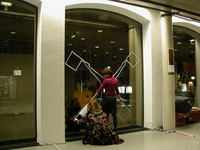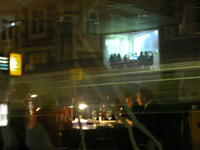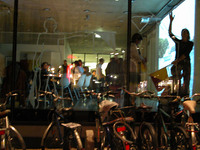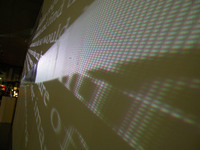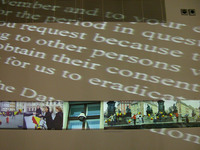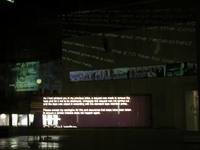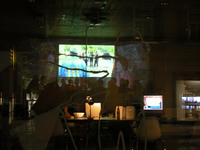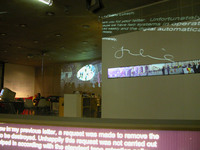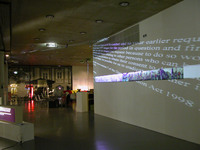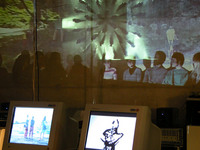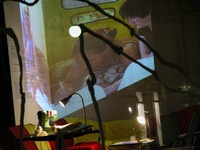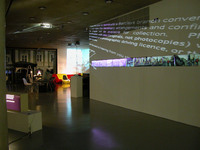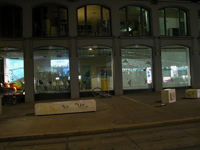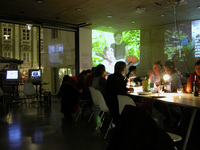Exhibition in progress
The concept of "Hinter den Zeichen" consisted of a worklab, where all research materials and current semaphore performance sessions in the city were put into the shape of an exhibition in progress. Step by step, recent and former activities were compiled on monitors, projectors and walls of the Medienkunstlabor (Laboratory of Media and Arts), exploring the effects of changing combinations of materials. (Eva Ursprung)

Mix it!
A Statement by Manu Luksch
The Medienkunslabor in Graz, were the curatorial experiment took place, is located at the ground floor of Kunsthaus Graz, with big shop front windows facing a busy tramway stop. Artist and curator Eva Ursprung was commissioned to run the space for a months time. She decided to make use of the space to develop presentations and of the timeline to to let projects evolve.
I arrived at its doorstep during half-time with a truck full of objects of the Faceless Project - a piece about video surveillance and legal issues around data protection. Eva and her colleagues had already set up a display of ideas and objects relating to the Talking the Fish project - a piece about the use of semiphore language to transfer data protocols, a practice the group continued underneath the city's public CCTV system. This was the content-related crossing point of the show-in-progress.
The possibilities of presenting art works are unlimited. I have always been quite intrigued by the 'cornershop' approach of cramming as many pieces onto the walls as possible, practiced for example by one of the collections, which opened itself to the public as one outcome of the French Revolution, the Louvre. Most painting galleries hang paintings up to the ceiling in many rows with little space inbetween. A more recent but less radical example: Cities on the Move at Secession, in Vienna. Much to the dismay of the participating artists, works filled every tiniest space to achieve the crowded feeling of Asian megacities, the very theme of the exhibition.
At Medienkunstlabor Graz, a strip of color photo prints and projections of documents shared the wall facing the street. The distorted projection included a white line in order to illuminate the images.
On a desk, there were a couple of PCs running slide shows on the screens, environments of the project: in color, the river bank, in greytones, the neighbourhood full with surveillance cams. Another projection piece had a second projection of a faster paced trailer-type video projected in the middle.
Looking at the window front from the street, the eye would meet a silhoutte figure holding two flags, drawn with chalk onto the glass surface, behind, light boxes, displaying excerpts of written communication.
The reactions were manifold. There was the occasional sunday audience on their way to the exhibition upstairs (needless to say: each sculpture placed within a wide white space, works labeled and explained), who were in need of explaination at the sight of the media lab type of setting - chairs, table, PCs - admidst all the art?
In bigger numbers, members of the local scene flocked in. We would have conversations and gradually they saw the many layers of various works, meaning not unrelated but of different projects and artists, deconstructing the composition Eva and I had spun across the space. And then there was a group of individuals who returned to the space to persue a deeper interest, follow presentations, participate in workshops, see the show evolve and change.
The experience convinced Eva and me that exhibitions not only profit from a degree of unpredictability (not only did it grow but once installed items kept changing position or content), but also from a blur of project blur of project boundaries, overlap and mix.
Photos: Eva Ursprung, Manu Luksch, Doris Jauk-Hinz, cym

